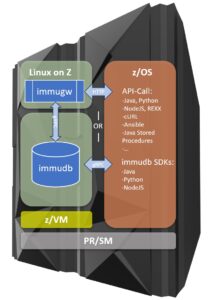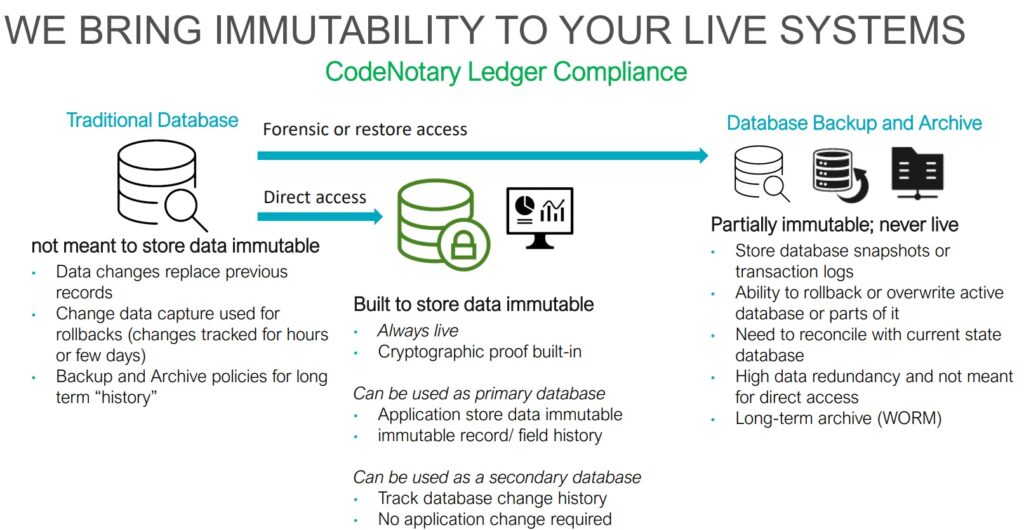Written by Sebastian Wind, graduate of the Open Mainframe Project Mentorship Program

My name is Sebastian Wind, I was a Global Winner of Master the Mainframe and an Intern of the Open Mainframe Project in 2017. Since then I always try to combine z/OS knowledge with the latest technologies of the open-source world.
I’ve been working in financial IT for 3 years now. Even at the bank that is managing my own bank account. Of course, we talk about IT-security at work and I was always curious where my balance was stored. Could my balance be manipulated? How could it be done? The answers didn’t satisfy me. Most organizations can’t really prove the origin of their software in production once the code left git. What components are being used in the software? When are they used? What is currently in the build process and what is currently running in the production environment? Who introduced what component? Who approved what artifacts before being deployed? The reason these questions are so important is because there is no better way to manipulate or to get access to data than to do it like the targeted organization itself. I tried to find answers to these questions. Relying on limited privileges is certainly not enough, administrators and operators need a lot of privileges to do their job. Messing with certificates is cumbersome and expensive. Certificates have the downside that they cannot be easily revoked, can only be issued once for every object, cost a non-trivial amount of money, can be issued in a malicious way that the user cannot distinguish between a real and a forged certificate, and additionally, not the workflow is certified by the certificate but only the result is. No way I would touch them, that’s when I came across immudb.
Immudb is an open-source, lightweight, high-speed immutable database with built-in cryptographic proof and verification. I had my first contact to open-source on a mainframe while being an intern for the Open mainframe project (Linux Foundation). Since then I was always looking for technologies that could leverage applications on the mainframe. Immudb is written in golang and can run on almost every architecture. It is able to store data immutably and tamperproof. Once something is added to immudb, it can’t be changed without traces. This allows you to keep an indelible history of sensitive data, for example, debit/credit card transactions or datasets and it’s members. Traditional DB transactions and logs are hard to scale and are mutable. So there is no way to know for sure if your data has been compromised. As such, immudb provides unparalleled insights retroactively of changes to your sensitive data, even if your perimeter has been compromised. immudb guarantees immutability by using cryptographic data structures internally. Immudb carries along a Merkle tree, which is statically connected to the data, so the construct cannot be unraveled. The client trusts the storage because he can proof and recalculate it. On top of that immudb is faster than its commercial competitors like QLDB from Amazon.
A huge percentage of the world’s most valuable data is processed on IBM mainframes. Mainframes are designed with reliability and security in mind since day one. Many libraries on mainframes should only be changed through a trusted development/build process. Tampering central and highly critical programs on a mainframe infrastructure of an organization would be a strike at the heart. Attacks like Sunburst showed that cyber-criminals act opportunistic and are able to create huge damage by tampering software. Hackers won’t stop at system frontiers but instead, look for a weak spot. Sometimes even mainframes get in their focus although known for being a highly secured platform. One example of that has been the Logica-Nordea mainframe hack. Next to cyber-security threats orchestrated by state-funded hacker organizations is the possibility of a malicious insider attack by bad actors like employees. Although this scenario is not very common the consequences would be equally devastating. The only secure way back for an organization using mainframes would be offline immutable tape storage, which is great but slow. Even then most questions from above would still be open. That’s why I started to get involved in the CodeNotary project, the developers of immudb.
Immudb architecture on IBM Z
 Immudb is lightweight and at the same time delivering unprecedented performance. Every Hardware-Architecture that is supported by golang will be able to run immudb. S390X is the Architecture of IBM Z and it is fully supported. The immudb server should run in a different and protected environment. LPAR partitioning on IBM Z is EAL5 certified therefore offering a high level of protection. Of course, immudb is also able to run next to a mainframe on distributed systems.
Immudb is lightweight and at the same time delivering unprecedented performance. Every Hardware-Architecture that is supported by golang will be able to run immudb. S390X is the Architecture of IBM Z and it is fully supported. The immudb server should run in a different and protected environment. LPAR partitioning on IBM Z is EAL5 certified therefore offering a high level of protection. Of course, immudb is also able to run next to a mainframe on distributed systems.
We propose running immudb on Linux on Z on a different LPAR communicating with z/OS over in-memory HiperSockets reducing overhead and latency. Immugw is a middleware that provides a REST-API for immudb. The API can be consumed by z/OS through various programming languages and scripts. Take a look at rocket software’s open source tools for z/OS to expand your scope with tools like cURL.
Another very lean option is to use our SDKs. Z/OS is supporting three languages with already existing SDKs: Java, Python and Nodejs. The SDKs are relying on the very fast and efficient gRPC (gRPC Remote Procedure Calls) protocol based on HTTP/2 and protocol buffers.
Immudb and immugw can be deployed on Linux on Z without a hassle. Git clone the repositories and install golang. Switch to the repositories directory and type: make all. Start up ./immudb and ./immugw. Done.
Use case 1 – trusted build process
One challenge of running highly critical systems is to ensure that no one tampered production software, as I described above. Let’s start with a basic example, a developer pushed code into a protected library. Now he wants to notarize that member using immudb. He can do so by using a batch job that has the following steps: – Step 1: pull the original signing program or script and verify it – Step 2: generate checksum of his source code and set it in immudb
Now a build-job would look almost the same. First, the source will be verified. With immudb it is also possible to look up the history. An object with an unclear history wouldn’t be able to get into production.Each stakeholder (machine or developer) of the process can notarize and authenticate objects, therefore adding trust to the process. The program can then be build from the trusted source and the resulting load module has to be notarized. ### Example
In this blog we are showing how to communicate with immudb/immugw by using java on IBM Z. Java is a good candidate because it works in every environment even in Db2 as a stored procedure. It is even possible to backup data of DB2 tables on change. More about that later.
Our Java program can be run as a step in JCL Jobs (for example: build jobs or jobs that are altering). The target dataset can be set as a variable in JCL and passed to the java program.
//JAVAJVM EXEC PGM=JVMLDM&VERSION,REGION=®SIZE, // PARM='&DATASET' //STEPLIB DD DSN=&LIBRARY,DISP=SHR //SYSPRINT DD SYSOUT=* <System stdout //SYSOUT DD SYSOUT=* <System stderr //STDOUT DD SYSOUT=* <Java System.out //STDERR DD SYSOUT=* <Java System.err //CEEDUMP DD SYSOUT=* //ABNLIGNR DD DUMMY //* //*The following DDs can/should be present in the calling JCL //* //*STDIN DD <OPTIONAL - Java System.in //*STDENV DD <REQUIRED - JVM Environment script //*MAINARGS DD <Preferred method to supply args // PEND
The code snippet below is showing a clean way of doing HTTP-API calls with only using HttpURLConnection. That way you will not face missing dependencies in different runtime locations. The function postRequest needs to be provided with the URL of immugw and a JSON-string. The JSON-string will be converted to bytes and posted. The response is being returned.
import java.io.BufferedReader; import java.io.IOException; import java.io.InputStreamReader; import java.io.OutputStreamWriter; import java.io.OutputStream; import java.net.HttpURLConnection; import java.security.Provider; import java.net.URL; public class Main { public static String postRequest(String urlStr, String jsonBodyStr, String authorization) throws IOException { URL url = new URL(urlStr); HttpURLConnection httpURLConnection = (HttpURLConnection) url.openConnection(); httpURLConnection.setDoOutput(true); httpURLConnection.setRequestMethod("POST"); httpURLConnection.setRequestProperty("Content-Type", "application/json"); if (authorization != ""){ httpURLConnection.setRequestProperty("Authorization", authorization); } try (OutputStream outputStream = httpURLConnection.getOutputStream()) { outputStream.write(jsonBodyStr.getBytes()); outputStream.flush(); } if (httpURLConnection.getResponseCode() == HttpURLConnection.HTTP_OK) { try (BufferedReader bufferedReader = new BufferedReader(new InputStreamReader(httpURLConnection.getInputStream()))) { String line; while ((line = bufferedReader.readLine()) != null) { return line; } } } return "Error code: "+Integer.toString(httpURLConnection.getResponseCode()); }
The first request will be the login request. The Api returns a token that will be used as authorization string later on.
String URLString = "http://LINUXONZ:3323/v1/immurestproxy/login"; //jsonInputString for default credentials, note b64 encoded String jsonInputString = "{\"user\": \"aW1tdWRi\", \"password\": \"aW1tdWRi\"}"; String response = postRequest(URLString,jsonInputString,""); System.out.println(response);
Read in the file for creating the checksum. Use JZOS (com.ibm.jzos) and a hash-function of your favor. It is recommended to use IBM Z’s extensive crypto-hardware support (for example for hash functions) like IBMJCECCA. Set the dataset name and its hash value in immudb. Look into our immugw blog to read more about using the immugw api.
String ddname = ZFile.allocDummyDDName(); String cmd = "alloc fi("+ddname+") da(HLQ.MYDATA) reuse shr msg(2)"; ZFile.bpxwdyn(cmd); RecordReader reader = null; try { reader = RecordReader.newReaderForDD(ddname); byte[] recordBuf = new byte[reader.getLrecl()]; while ((bytesRead = reader.read(recordBuf)) >= 0) { ... }
Getting checksums of datasets on change event
With z/OS it is possible to detect changes of datasets. There are two ways of doing that. Either write a started task and listen to the SMF realtime api (SMF15) or monitor a module that gets loaded by CLOSE via CSVEXIT. Intercepting the CLOSE SVC is a delicate job but possible. Then use the name of the changed dataset create a hash and set it in immudb. That way you can track changes of datasets immutably and tamperproof.
Overcoming EBCDIC and ASCII conversion challenges
Objects will change their checksum when they are converted from EBCDIC to ASCII and the other way around. Many code signing solutions will lose track of the object. Immudb is capable of storing JSON-Objects as value. Metadata can be added to an object including the ASCII/EBCDIC checksum of the object or many other information.
{ "ascii.checksum" : "d7e4d83a94d161837aa4038cbaf9708b2bb2d91675a20493a982ce4b17d8012e" "ebcdic.checksum": "cffeab52f4f186936e3697bf1c69a6ec72d298ff94e0b40d603f453285707e2e" }
Use case 2 – backing up data immutably
A possible cyber-attack could focus on databases. Bad actors could gain access to databases by using SQL injections or other methods. They then use their access levels to encrypt whatever they get their hands on. Immudb can keep up with the fastest databases and back up their data. Read more about that in our randomware blog. Keep in mind: immudb has to be run in a different protected environment. Now, even if immudb writes encrypted values, it still has the history of the record that can not be touched.
This is how it works: triggers in Db2 will notify about changes of tables. Set an alter trigger and execute a stored procedure to store the new data of the table in immudb. Push the java code to Db2 and create the stored procedure. After that, it is callable by SQL. When the trigger is called, set the parameters and call javaproc. Use the OUT STATUS variable to report the HTTP-Code.
CREATE PROCEDURE JAVAPROC (IN TABLE CHAR(99), IN COLUMN CHAR(99), IN KEY(99), OUT STATUS INTEGER) NOT DETERMINISTIC LANGUAGE Java PARAMETER STYLE JAVA EXTERNAL NAME 'DS_20180823161823:com.userid.JAVAPROC.x_JAVAPROC' COLLID NULLID WLM ENVIRONMENT D121WLM_JAVA
Call the stored procedure with SQL:
CALL IMMUDB.JAVAPROC(:TABLE, :COLUMN, :KEY, :OUT)
Immudbs performance can keep up with high-speed databases. Add immutability to your database, not just by offline tape.
Innovation for your future proof hardware
 The hardware of IBM Z is suited very well for the crypto technologies of the future. Get the best of both worlds Linux and z/OS and make your system immutable. Back up critical data or secure your build process. Proof immutability for your transaction-logs. Or maybe you already have a use-case in mind we didn’t even think about yet. Start coding and create answers to very important questions in a world where digital trust becomes more and more significant.
The hardware of IBM Z is suited very well for the crypto technologies of the future. Get the best of both worlds Linux and z/OS and make your system immutable. Back up critical data or secure your build process. Proof immutability for your transaction-logs. Or maybe you already have a use-case in mind we didn’t even think about yet. Start coding and create answers to very important questions in a world where digital trust becomes more and more significant.
